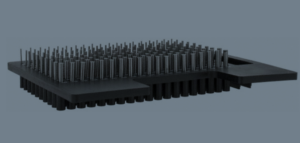How to Minimize the Effects of Heat on the Measurement of Metal Parts
At the height of summer here at Metal Cutting Corporation, our thoughts naturally turn to the weather and the ways in which heat can affect:
- The materials our customers choose
- The tools used to measure the tight tolerance, small metal parts we make in our air conditioned factory
The issue is that heat can cause metals (and other materials) to expand — and in the cold, to contract — which in turn can impact whether a part is in or out of spec.
This is especially true when you have very tight tolerances (such as ± 0.0001″, or ± 0.0025 mm) and heat expansion results in either metal parts failing inspection or, more commonly, a customer and supplier coming up with different measurements for the same part.
That’s why manufacturers, designers, and engineers need to keep metal expansion from heat in mind when they create part specifications and decide how precise the part’s dimensions need to be.
Heat Expansion in Different Metals
What does heat do to metal? The expansion (or contraction) of any material is due to the kinetic energy of its atoms. When a material is heated, the increase in energy causes the atoms and molecules to move more and to take up more space— that is, to expand.
This is true of even a solid such as a metal. However, different metals respond to heat to a different extent depending on each one’s unique coefficient of thermal expansion.
So, for instance, if you took three wires of the same diameter but made of three different metals — such as aluminum, steel, and tungsten — and heated them to the same temperature, each wire would expand by a different amount.
Naturally, the thermal characteristics of the material a customer chooses for their metal components has an effect on the potential for heat expansion. So if you have a very tight tolerance part, you probably want to choose a metal that is highly stable and not subject to a lot of variation due to changes in temperature.
Heat and the Calibration of Measurement Tools
We often talk about the importance of how a part is inspected and choosing an appropriate and properly calibrated measuring tool for the job.
But did you know temperature and other conditions in the environment (such as humidity and pressure) can have an impact on the resulting measurements when you are checking whether manufactured parts are within specs?
Theoretically, manufactured parts should always be measured at the same temperature under which the chosen measuring tool was calibrated. However, the reality is that on many shop floors, there often is no way to know the ambient temperature — much less control it and make sure it matches the environment (or environments) where various measuring tools were calibrated.
In addition, high relative humidity — the amount of moisture in the air expressed as a percentage of the saturation possible at a given temperature — in combination with fluctuating temperatures often causes condensation that can affect gages and more sensitive metrology equipment. With high, long-term exposure, humidity can cause warping and, eventually, corrosion, both of which have an impact on measurement accuracy.
Other Factors in the Heat Expansion of Metals
When a part is measured can also have an effect on temperature and, therefore, the dimensions of the part. For instance, a freshly cut part may be hot or cold and therefore have a slightly different dimension than if it was measured later in Quality Assurance (QA) or when inspected upon arrival at a customer’s manufacturing location.
Atmospheric pressure can also have a very subtle impact on parts measurement, with metals expanding when they are under less pressure. That means if you cut and inspect a part at sea level and then ship it to Denver, you might get a very slightly different measurement at the higher altitude — of course, seen only when measuring the smallest of dimensions and tightest of tolerances.
In addition, the heat expansion of metals depends on the magnitude of the part size. For instance, the tolerance affects the coefficient of expansion, in that differences in measurement are more likely where very tight tolerances are associated with larger parts, such as one that is a foot or more in length versus one that is 0.001” (0.0254 mm) in length.
That means it is more difficult to hold a tight tolerance on a rod that is, say, 2’ (60.96 cm) in length, with any variation being more obvious. Also, the bigger the diameter, the more difficult it is to keep a tight tolerance.
Another factor is that multiple materials may be used in a product comprising different assembled parts, and each material has its own coefficient of thermal expansion. These different parts — perhaps some made from different metals and some from plastic, glass, or other materials — will expand at different rates. Therefore, the differing coefficients of expansion need to be considered when deciding on tolerances across the various parts.
How to Minimize Metal Expansion from Heat
In a perfect world, all parts would be cut and inspected by a supplier and then inspected and used by the manufacturer/customer in virtually identical environments.
While achieving exactly identical temperature and humidity is unlikely, there are steps that can be taken to minimize or eliminate the effects of heat expansion of metals and other atmospheric conditions.
For example, at Metal Cutting we have a controlled environment for both producing and measuring the small parts we make. Our cooling and heating systems ensure that manufacturing activities occur at room temperature, in an environment that is largely consistent throughout our facilities — starting with where we calibrate our measuring tools and extending across our shop floors and QA areas.
As a result, we rarely see any variation in our measurements due to temperature fluctuations and the heat expansion of metals. In addition, because we always strive to achieve the nominal dimensions for all the parts we produce, we typically do not see parts varying in and out of tolerance.
However, the same may not be true for a few of our customers and their manufacturing sites, where operating conditions can vary greatly.
For instance, some factories don’t have air conditioning (or heating) in their production facilities but do have a temperature-controlled inspection area where they check parts for quality. There, the unintended consequence may be a discrepancy between the parts as measured on a relatively hotter (or colder) shop floor versus their measurement in quality control.
In general, these effects are small and occasionally masked by tolerance range. But they do exist, and that is why it is important to consider them when producing and measuring parts — especially those with tolerances measuring in the tenths of a thousandth of an inch.
Best Practices Plus Good Engineering
Clearly, it’s good practice to make sure production, inspection, and quality control areas operate under the same environmental conditions wherever possible.
More importantly, it is crucial to think about where the end product will be used and whether a very small difference in tolerance due to possible heat expansion of metals would matter in how the final product or component performs. For example:
- Will the part ultimately be used in a controlled environment, where a tight tolerance can be maintained?
- OR will the product be used in a very hot environment, indicating a need to open up the tolerances so that the product’s functionality will not be jeopardized due to expansion?
These and other considerations are vitally important to specifying the dimensions and tolerances that will produce the finished parts that your project requires.






